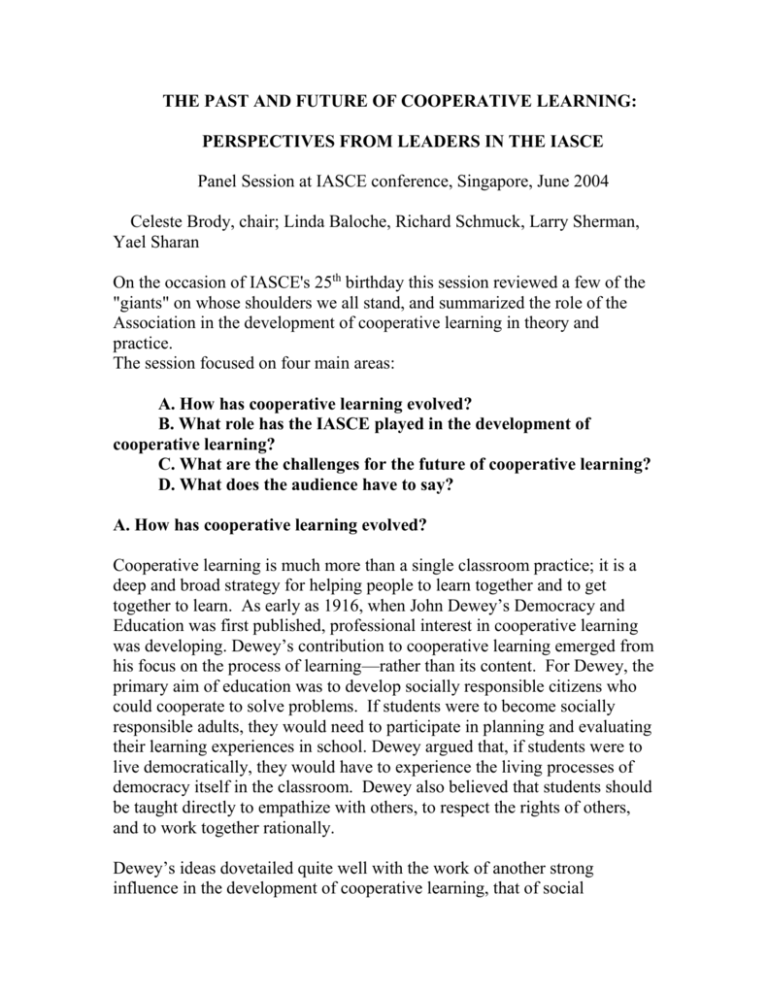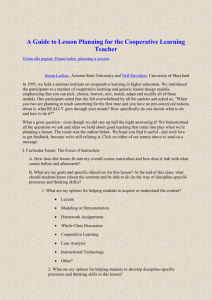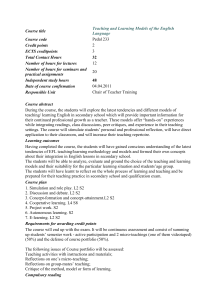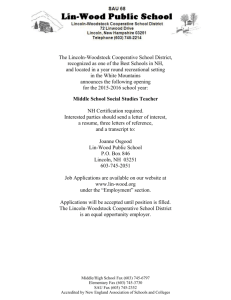The past and future of cooperative learning
advertisement

THE PAST AND FUTURE OF COOPERATIVE LEARNING: PERSPECTIVES FROM LEADERS IN THE IASCE Panel Session at IASCE conference, Singapore, June 2004 Celeste Brody, chair; Linda Baloche, Richard Schmuck, Larry Sherman, Yael Sharan On the occasion of IASCE's 25th birthday this session reviewed a few of the "giants" on whose shoulders we all stand, and summarized the role of the Association in the development of cooperative learning in theory and practice. The session focused on four main areas: A. How has cooperative learning evolved? B. What role has the IASCE played in the development of cooperative learning? C. What are the challenges for the future of cooperative learning? D. What does the audience have to say? A. How has cooperative learning evolved? Cooperative learning is much more than a single classroom practice; it is a deep and broad strategy for helping people to learn together and to get together to learn. As early as 1916, when John Dewey’s Democracy and Education was first published, professional interest in cooperative learning was developing. Dewey’s contribution to cooperative learning emerged from his focus on the process of learning—rather than its content. For Dewey, the primary aim of education was to develop socially responsible citizens who could cooperate to solve problems. If students were to become socially responsible adults, they would need to participate in planning and evaluating their learning experiences in school. Dewey argued that, if students were to live democratically, they would have to experience the living processes of democracy itself in the classroom. Dewey also believed that students should be taught directly to empathize with others, to respect the rights of others, and to work together rationally. Dewey’s ideas dovetailed quite well with the work of another strong influence in the development of cooperative learning, that of social psychologist Kurt Lewin. Even though Lewin and Dewey were personally unacquainted, there was a community of spirit between the Prussian-born psychologist and the American-born philosopher. Both were deeply interested in the group dynamics of cooperation. It was primarily Lewin, however, who spearheaded dual work on both the scientific and practical aspects of group dynamics. For Lewin, group dynamics was a complex combination of science, creativity, social reconstruction, and planned change. From Lewin’s perspective, if research on groups had no implication whatsoever for social improvement, then doing it would have little value. Lewinian thinking came to fruition in the scientific research of Morton Deutsch and the action research of Ronald Lippitt, both of whom were Lewin’s students. Links between Dewey and Lewin—with special emphasis on the value of cooperation for learning—were forged by Herbert Thelen, who developed an inquiry strategy for students learning together in small groups and suggested ways to help student groups function effectively. B. What role has the IASCE played in the development of cooperative learning? The IASCE, formed in Israel in 1979, set out to build on the work of the early pioneers in cooperative learning. IASCE sought to be an international body of educators with the common interest of studying cooperation in education. The word “study”-- meaning the pursuit of knowledge by attentive scrutiny, observation, reading, trial and error, or research—was deliberately chosen at the conference to include a broader array of knowledge-production activities than the word “research” alone might connote. Of course, the founders of the IASCE wanted to include both quantitative and qualitative research, but more than that, they sought to include professional reflection, case studies, attentive observation, teacher exchange, and action research. Participants at the first conference also settled on the term "cooperative learning," which was, until then, used synonymously with "cooperative planning," "group process," "group work," and "small group teaching." Another choice was the deliberate use of the word “education” in the name of the Association, to include all system levels involved in the process of education. Thus, along with the varieties of classroom-based, cooperativelearning models and strategies that might be studied, they wanted to include the examination of more macro-system levels such as organization development of school faculties, cooperative, school-based community relations, the cooperative educational community, the cooperative school board, etc. Indeed, Richard Schmuck, the first president of IASCE, opened the 1979 conference with a keynote address focused both on the use of organization-development strategies to engage students in school-wide governance and on how students might work cooperatively with teachers and administrators to establish cooperative cultures. For the IASCE, the 1980s were a period of rapid growth. Many regional affiliates were formed, with the primary purpose of providing services to members who were practitioners. Regional conferences tended to offer workshops on varied cooperative learning practices, while international conferences (in Israel, Canada, and the United States) tended to focus on dissemination of research, projects, and publications plus continuing discussion of “big” ideas and issues. The IASCE published a newsletter throughout this period. A content analysis of these newsletters indicates that research focused on: (One) the effects of cooperative learning strategies and methods on achievement, social interaction, and cognitive processes in various content areas and at various grade levels; (Two) the effects of school organization in the implementation of cooperative learning; (Three) similarities and differences among methods—with attempts at a general taxonomy; (Four)students’ and teachers’ perceptions of cooperative learning; (Five) the effects of cooperative strategies and methods on inclusion; and (Six) the effects of group composition, size, task structure, discussion, and helping behaviors on learning. Beginning in early 1990, IASCE published the magazine Cooperative Learning to assist educators in utilizing cooperative learning effectively in a variety of contexts, grade levels, and subjects. Between 1990 and 1996, the IASCE also worked with several regional affiliates to co-sponsor four large conferences in North America. University-based researchers continued to expand the research base for cooperation in such areas as conflict resolution, teacher education, staff development, and special education. By the mid 1990s, the IASCE recognized that although cooperative learning was a regular topic in professional association publications and was widely acknowledged as best educational practice, it had yet to penetrate deeply into institutional and organizational life. With this in mind, the Association (a) discontinued publication of its magazine; (b) expanded its newsletter so that it would be a reliable source of information about research and publications in cooperative learning; and (c) began to focus on projects that brought its expertise to improving teacher education and staff development by working with major research associations and supporting work on several book-length publications. During the 1990s, the IASCE also co-sponsored conferences in Australia, the Netherlands, and Sweden. At a conference held in Toronto in 1999, the Association made a strong commitment to increasing its international focus and outreach. In keeping with this commitment, the Association (a) lowered membership dues to make membership more affordable and accessible in developing areas of the world; (b) expanded its use of electronic communications media to increase access to quality, not-for-profit information about cooperative learning; and (c) agreed to develop new, and diverse, conference venues. In 2000, the IASCE Newsletter published a review of current research topics in cooperative learning. This review, written by Shlomo Sharan, (the Association's first secretary and second president), highlighted the main research interests up to that time. By 2000, research interests included: (a) social and academic outcomes of student interaction; (b) student preparation for cooperation; (c) the development of clear criteria for discussion and evaluation; (d) student motivation; (e) cooperative learning in various content areas; (f) the effects of verbal interaction; (g) pre-service and inservice teacher development; (h) teacher concerns, satisfaction, and efficacy; and (i) the use of cooperation in specific situations such as special education and bilingual education. C. What are the challenges for the future of cooperative learning? Our 2002 conference in Manchester, England brought together researchers and practitioners from approximately 20 countries on four continents. For the first time, we heard multiple voices from both Eastern Europe and Asia and we learned about and from the UK commitment to cooperative enterprise. Here, in Singapore, we again benefit from multiple voices and perspectives, with conference presentations and attendees from approximately 20 countries. This has been a genuinely exciting event, where participants—both those new to the Association and “regulars”—have explored the challenges and opportunities of cooperation in education. Exchanges at this conference have reinforced what we learned from ongoing conversations and publications about the strong need for, and engagement in, the development of research bases in differing cultural and political contexts that support policy and implementation of best practices in cooperative learning. This need is also emphasized in members' contributions to The Forum, a regular feature in the IASCE Newsletter, that report on the varying contexts where cooperative learning is developing. In some regions of the world, the context is one of moving away from totalitarianism; in others the context is a developing infrastructure and moving towards universal access to education; in still others it is a struggle with government mandates that seek to measure the education of children through decontextualized test scores. In all regions of the world the conversation continues about how to implement cooperative learning thoughtfully—how to “sell” cooperative learning without selling it short and how to develop the transformative power of cooperation for deep learning and change C. What are the Challenges for the Future? Before addressing future challenges we reviewed the basic topics that concerned educators involved in CL in the 1970s and 1980s, based on a content analysis of IASCE newsletters of the time: METHODS: generic & specific PROSOCIAL BEHAVIOR CONTENT AREAS ALL GRADE LEVELS INCLUSION ACHIEVEMENT GROUP PROCESSES SYSTEMS APPROACH: O.D. STAFF DEVELOPMENT TEACHER TRAINING STATUS TREATMENT ASSESSMENT This list of topics has not changed over the years, although there have been shifts in emphasis in research and in practice. Out of all these topics the essential elements of cooperative learning took shape, elements that cut across methods, content areas and grade levels: Teambuilding and class climate building Setting the stage for cooperative group work Structured discussion and interaction Attention to group processes Processing, reflection Task structure Positive interdependence Status treatment Assessment Balance between individual & group accountability and assessment Future research will attempt to be clearer about certain issues. Studies will: specify CL methods or procedures used in the study; specify how methods used in the study were implemented; specify the school environment in which the study took place. Research may expand to include these topics: Cooperation in intercultural education New initiatives that enable effective CL -practice -dissemination -research -teacher education D. What Does the Audience Have to Say? Participants in the session were invited to suggest additional challenges for the IASCE in the future. They expressed the hope that the IASCE would deal with the following topics: - Publish a refereed journal. - Promote the connection between I.T. and CL, between independent learning and CL, between IASCE and IAIE. - Promote more balance between research of CL and teacher input. - Continue to push CL to the forefront of teacher education. - Make more of an effort to reach education in poor countries. - Continue the discussion of what enables success and sustains it in the implementation of CL.





